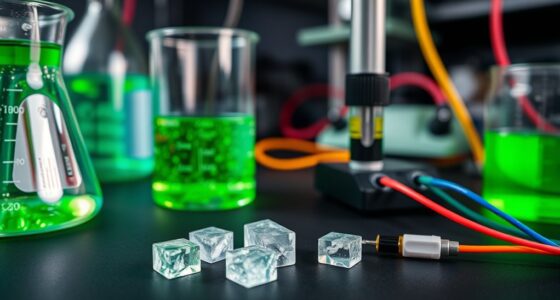Internal resistance gradually worsens as your battery ages, silently reducing its efficiency and causing power drops. Temperature plays a big role—hotter conditions speed up resistance growth and chemical breakdown, while cold can temporarily slow performance. Managing heat and proper charging habits can slow this decline, but over time, increased resistance leads to shorter device life and unexpected shutdowns. Keep exploring to uncover more ways to protect your battery’s longevity and performance.
Key Takeaways
- Increased internal resistance causes energy loss as heat, reducing battery efficiency and lifespan.
- Rising resistance accelerates chemical degradation, especially at higher temperatures, leading to faster battery aging.
- Elevated internal resistance results in voltage drops under load, causing device performance issues or shutdowns.
- Proper thermal management slows resistance growth, extending battery life and maintaining optimal performance.
- Regular monitoring and avoiding extreme temperatures help minimize resistance-related performance decline.

Have you ever wondered why a battery’s voltage drops under load? This phenomenon isn’t just a quirk; it’s closely tied to the internal resistance within the battery. As your battery ages, its internal resistance naturally increases, making it less efficient at delivering power. Over time, chemical changes and wear inside the cells cause the internal components to become less conductive, which means more energy is lost as heat rather than powering your device. This process, known as battery aging, is a silent but significant factor in diminishing overall performance.
Thermal effects play a vital role in this deterioration. When a battery operates at higher temperatures, the internal resistance tends to rise even faster. Heat accelerates chemical reactions inside the cells, leading to faster degradation of the active materials. That’s why, if you regularly use a device in hot environments or keep your batteries in warm places, you might notice more frequent voltage drops and shorter battery life. Elevated temperatures cause the internal resistance to spike, which not only reduces efficiency but also increases the risk of overheating and potential damage. Conversely, cold temperatures can temporarily increase resistance, making the battery less responsive, which is why your smartphone might drain faster in the winter.
Higher temperatures speed up battery resistance, causing faster degradation and shorter lifespan; cold increases resistance temporarily, reducing responsiveness.
Understanding these thermal effects helps you see why proper battery management is essential. If you keep your device cool and avoid exposing it to excessive heat, you slow the aging process and keep internal resistance lower for longer. Proper charging habits, avoiding overcharging or discharging completely, also help mitigate rapid resistance increases caused by chemical stress. As resistance climbs, more energy is diverted to overcoming these internal barriers, leading to voltage drops when you need power most. This means your device might shut down unexpectedly or underperform, especially during heavy use.
In essence, internal resistance isn’t just a technical detail; it’s a key factor that influences how well your battery performs over its lifespan. The longer it takes for resistance to rise, the longer your battery remains reliable. Paying attention to factors like battery aging and thermal effects allows you to extend battery life and avoid sudden performance issues. By managing heat exposure and adopting good charging habits, you can minimize the impact of internal resistance. Recognizing these patterns empowers you to make smarter choices, ensuring your devices stay powered efficiently and reliably for as long as possible.
Frequently Asked Questions
How Does Temperature Affect Internal Resistance?
Temperature markedly influences internal resistance by causing thermal effects that alter the battery’s performance. As temperature increases, resistance measurement typically decreases because the thermal energy improves ion mobility within the battery. Conversely, at lower temperatures, resistance rises, reducing efficiency. You should monitor these thermal effects closely, especially during resistance measurement, to guarantee ideal battery function and longevity. Proper temperature management helps prevent performance drops due to internal resistance changes.
Can Internal Resistance Be Completely Eliminated?
You might wonder if internal resistance can be entirely eliminated. While advancements in battery recycling and precise resistance measurement help reduce resistance, completely removing it isn’t realistic. Internal resistance is inherent due to material properties and chemical processes inside the battery. Even with improvements, some resistance persists, affecting performance. So, instead of elimination, focus on minimizing resistance to optimize battery lifespan and efficiency.
What Are Early Signs of High Internal Resistance?
You might notice early signs of high internal resistance through reduced battery capacity and longer charging times. Electrode degradation and electrolyte aging contribute to this issue, causing the battery to heat up more during use. You may also observe voltage drops under load or inconsistent performance. These signs indicate that internal resistance is increasing, which can silently diminish your battery’s efficiency over time if not addressed promptly.
How Does Internal Resistance Impact Battery Lifespan?
Internal resistance affects your battery’s lifespan by accelerating battery degradation over time. As resistance increases, your battery struggles to efficiently transfer charge, leading to reduced capacity and fewer usable charge cycles. This means your battery will wear out faster, losing its ability to hold a full charge. To prolong its life, monitor performance and avoid deep discharges or high charge rates that can worsen internal resistance and shorten your battery’s effective lifespan.
Are There Specific Battery Types More Prone to High Internal Resistance?
Imagine your battery’s potential is subtly hindered by its makeup. Certain battery chemistries, like nickel-metal hydride, tend to develop higher internal resistance over time, especially if manufacturing quality isn’t excellent. Lithium-ion batteries generally perform better, but lower-grade versions may be more prone to this issue. So, when choosing a battery, consider its chemistry and manufacturing standards to guarantee longevity and ideal performance.
Conclusion
Understanding internal resistance is key to maximizing your battery’s performance. Did you know that a 50% increase in internal resistance can reduce a battery’s efficiency by nearly 30%? By monitoring and managing it, you prevent performance drops and extend your battery’s lifespan. Don’t overlook this silent killer—taking simple steps now can save you from costly replacements later. Stay aware, stay proactive, and keep your batteries working at their best!










